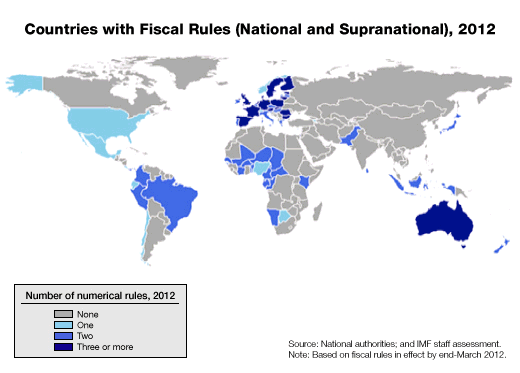
Typical street scene in Santa Ana, El Salvador. (Photo: iStock)
IMF Survey: IMF Tracks Fiscal Rules Used in Crisis Response
July 25, 2012
- Growing number of countries now have fiscal rules in place
- "Next generation" fiscal rules better account for economic shocks
- New IMF dataset covers fiscal rules in 81 countries
With the focus on stronger national fiscal rules in Europe and elsewhere in the world, new IMF research will assist policymakers in designing fiscal rules that help bolster their countries’ fiscal positions.

EU member states are among the many countries worldwide to adopt fiscal rules (photo: Thierry Roge/Reuters)
Government Debt & Deficits
Building up national fiscal frameworks, in particular through imposing numerical rules on budgetary aggregates such as spending, deficits, or debt has emerged in many economies as a response to the crisis. With public finances in distress and some countries facing strong market pressures, many have sought to strengthen their fiscal frameworks, while also ensuring better interaction among many of their main elements.
Adopting fiscal rules is one way that governments can help bridge the transition to lowering currently high fiscal imbalances while enhancing the credibility of their overall fiscal consolidation plan. But in formulating these rules, governments must strike the right balance between ensuring credibility and maintaining flexibility in the face of shocks. Furthermore, they have to weigh a multitude of considerations, including the legal basis of the rule, its coverage and flexibility, enforcement mechanisms, and whether to include other supporting arrangements to reinforce credibility of the rule.
“We think our analysis can offer policymakers a tool that provides timely information and allows for quick cross-country comparisons of different types of fiscal rules in place around the world,” said Andrea Schaechter, one of the authors of the study. “Often, government authorities and researchers spend a lot of time gathering this information themselves, so here we’ve stepped in facilitating these efforts with our new dataset, which provides country-by-country descriptions of the rules and their key features.”
Rules of engagement
Fiscal rules are legal or political commitments that impose long-lasting constraints on key fiscal indicators through numerical limits on deficits, debt, expenditures, or revenue. For example, a government might be prevented from amassing debt greater than a threshold defined in percent of its GDP, from running a deficit larger than a certain limit, or from raising spending annually more than, for example, potential GDP growth. Oftentimes, countries use a combination of fiscal rules. Fiscal rules can help contain pressures to overspend, particularly in good times, and thereby ensure fiscal responsibility and public debt sustainability.
Types of Fiscal Rules
A fiscal rule imposes a long-lasting constraint on fiscal policy through numerical limits on budgetary aggregates.
Debt rules: Set a limit for public debt in percent of GDP.
Budget balance rules: Set limits on overall, primary, or current budget balances in headline or structural terms.
Expenditure rules: Set limits on total, primary, or current spending, either in absolute terms, growth rates, or in percent of GDP.
Revenue rules: Set ceilings or floors on revenues aiming to prevent an excessive tax burden or boost revenue collection.
Rules can be found at the national level, as well as in monetary unions at the supranational level. One example is the Maastricht criteria that set limits for European Union members of 3 percent of GDP for the overall fiscal deficit and 60 percent of GDP for the general government debt. Recently, new initiatives such as the “Fiscal Compact” aim to reform these rules by strengthening enforcement while adding flexibility to deal with economic cycles.
In new research the IMF takes stock of fiscal rules in use around the world since 1985. A new dataset covers national and supranational fiscal rules in 81 advanced, emerging, and low-income countries from 1985 to end-March 2012, and presents details about the rules’ key design elements, particularly in support of enforcement.
Key findings
The IMF study confirmed that many new fiscal rules have been adopted and existing ones strengthened in response to the crisis. It also revealed that the number of fiscal rules and the comprehensiveness of the design features in emerging economies has caught up to those in advanced economies.
The research also sheds light on so-called “next-generation” fiscal rules. These rules are designed and aimed to strike a better balance between sustainability and flexibility goals, because they tend to account for economic shocks and are often complemented by other institutional arrangements, such as fiscal councils. At the same time, however, “next-generation” fiscal rules also tend to be more complex, thereby creating new challenges for implementation, communication, and monitoring.
“Over the past two decades, fiscal rules have spread worldwide,” said Schaechter. “In 1990, only five countries had fiscal rules in place that covered at least the central government level. Today we see over 75 countries with national and/or supranational fiscal rules.”



